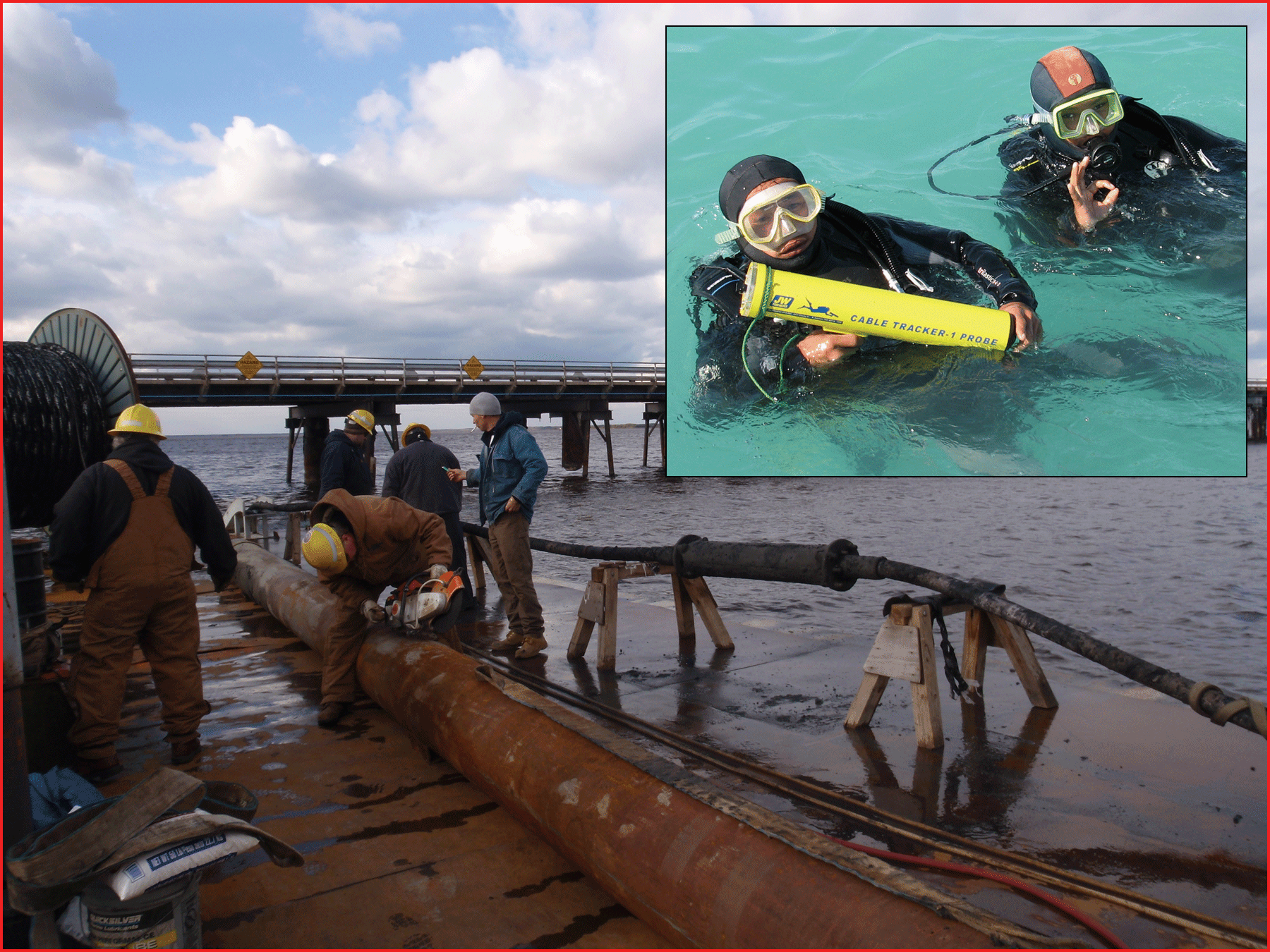
Hydro Marine's team works on repairing damaged power cable.
Inset photo: Southern Gulf Survey divers with CT-1 probe.
Trying to locate damaged subsea power and communications cables has always been a difficult job. Regulations require cables be buried from several feet to several meters under the ocean bottom to prevent snagging by boat anchors, fishing nets, lobster trawls, etc. The amount of overburden on a cable often means it's too deep to be located with conventional metal detection equipment. The device that has proved most effective in finding them is a cable tracker. This system has two parts, a signal injector and a probe. The injector is attached to the shore end of a line and induces a signal into one of the conductors. The probe is carried by a diver, or used from a boat in shallow water, and detects the electrical pulse transmitted through the wire. Live power cables do not require a signal to be induced. The probe can easily detect the 50 or 60 hertz frequency in the line. Live communications cables can also be detected without the use of the signal injector as the probe will detect the 1,024 Hz tone.
One company that recently completed a job with help from this tool is Hydro Marine Construction, a division of The Castle Group. Company founder William Castle has been providing marine and structural engineering services for almost 30 years, and has served on a number of industry boards including the Association of Diving Contractors (ADC). Hydro Marine was called on to assist Atlantic City Electric in locating and repairing a damaged submarine power line off the New Jersey coast. The first hurdle they faced was finding the cable, which was buried 4 to 9 feet under the ocean floor. Using JW Fishers CT-1 cable tracker, a signal was induced into the shore end of the line. Hydro's divers then used the CT-1 probe to locate and follow the cable until they pinpointed the exact location of the break. Buoys were deployed to mark the spot, and a water jet was employed to excavate the cable. Divers rigged it with a sling, and raised it to the surface with a crane. Once on top, the cable was anchored onto the company's barge. A crew from the electric company worked with Hydro's team to cut out the faulty section and splice in a new piece. When repairs were complete, the power line was lowered back to bottom and reburied.
Another outfit using the cable tracker is Michigan based Durocher Marine, which specializes in difficult marine and heavy construction projects throughout the US and Caribbean. The company performs a broad range of work that includes the installation and maintenance of submarine power and communication cables. Durocher was contracted to locate several underwater cables at NRG Energy's Norwalk Harbor Generating Station in Connecticut and mark their position. Project manager Tim Paquette contacted JW Fishers, a leading manufacturer of underwater search systems, for the right equipment. Fishers supplied a CT-1 cable tracking system, several acoustic pingers, and the PR-1 pinger receiver. Paquette reported. “With this equipment we were able to quickly find the cables, follow their path, and mark their position with the pingers.
Located in the United Arab Emirates is Southern Gulf Surveys, a company with substantial knowledge and experience in Hydrographic, Topographic, and Geophysical surveys. Best known for their work in dredging and reclamation, they have provided services to many international clients. Recently the company was hired to find and track several power cables. Managing director Stephen Hart reports, “The CT-1 cable tracker is doing its job. The cables we're searching for are 11 KVA and 50Hz. We got good signals both on the beach and offshore. We found the cables 70 meters out of position and buried down 1.5 to 2 meters. They were supposed to be 15 meters apart and buried down half a meter. The client commented that we've done what no one else managed to do!
For more information on Hydro Marine Construction go to www.wjcastlegroup.com. For more information on Durocher Marine go to www.durocher.biz. For more information on Southern Gulf Surveys go to www.sgsurveys.ae.
